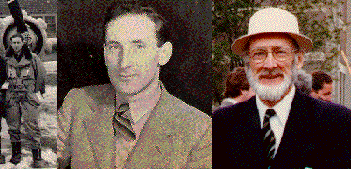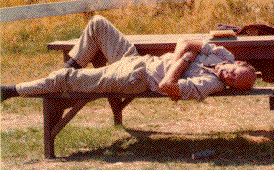The Many Faces of Dr. Ken Hooper
Return to HVPM Lobby
Dr. Ken Hooper served with the Royal Air Force during the Second World War, primarily in the European theatre. Following demobilization, at the war's end, he attended the University of London graduating with a B.Sc. in Geology, specializing on the "soft rock" side of the subject.
He subsequently journeyed to Australia where he taught biology and geology. While living in the Outback he took to flying a Chipmunk aircraft thinking that this would simplify and speed up geological observations in the field; only to discover that there was no substitute for walking over the ground and "hands on" study of the rocks.
A suggestion by Professor Martin Glaessner of the University of Adelaide that he should study a certain genus of Cenozoic foraminifera inititated an interest in microfauna that led to studies in x-ray microscopy, scanning electron microscopy and microbeprobe analysis of micro-organisms at the Cavaendish Laboratory, University of Cambridge for which he was awarded the M.Sc. degree of the University of London.
In 1958 he came to Carleton University in Ottawa, where the Department of Geology was in the early stages of development and where Dr. Alice Wilson of the Geological Survey of Canada had been teaching a course in paleontology on a part-time basis but was now retired.
In addition to teaching general geology and paleontology he initiated research into the microfauna of the Gulf of St. Lawrence and the Nova Scotian Shelf. This work was sponsored by the Canadian Department of Fisheries and necessitated going to sea in various vessels including the infamous H.M.C.S. "Sackville" a wartime corvette of 1000 tons, converted to a research vessel, with a "sickening" reputation. At this time studies of modern foraminifera were not regarded as geologically significant by many of the local geological establishment. However, as oceanographic and marine geological research picked up, and the discovery of sea-floor spreading led to theories of plate tectonics, the Geological Survey of Canada and then the Bedford Institute of Oceanography sponsored foraminiferal research, and employed many students during the summer field seasons.
The main thrust of Ken Hooper's work was relating foraminiferal and ecological factors in sediments and in water masses.
In 1964 he spent a sabbatical year in New York City studying the microfossil collection of the American Museum and attending graduate courses under John Imbrie on mathematical models, Betty Kellett on Ostracoda, Calvin Heusser on spores and pollen and Brooks Ellis on Petroleum Geology.
Upon returning to Carleton University in 1965 he applied mathematical methods of microfaunal analysis to eastern Canadian Holocene foraminiferal faunas for which he was awarded the Ph.D. (London)
During the 1970's two extended visits to Australia and the South Pacific gave rise to renewed interest by Dr. Hooper in Cenozoic and Mesozoic microfaunas of the region. Sedimentary rocks and modern sediments were collected and students were encouraged to study the contained microfaunas. Interest was not limited to sediments collected on land but extended to deep ocean sediments gained by the Deep Sea Drilling Program. This work continued into the 1980's thanks to the cooperation received from Scripps Institution of Oceanography.
In all approximately 40 studies of fauna, mostly foraminiferal, ranging from Mesozoic through Modern in age from various regions of North America, Australia, Europe, the South Pacific and North Atlantic oceans were produced by Honours, M.Sc., and Ph.D. students during his tenure.
Now retired, he is curating the Carleton University microfaunal collections.
Ken pondering a "weighty" paleontological problem
at Carleton's Cobalt Field Camp
Return to HVPM Lobby


